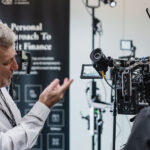
Triple threat: The Creator
Posted on Oct 3, 2023
In hotly anticipated sci-fi The Creator, cinematographer Oren Soffer artfully incorporates natural aesthetics to construct an engaging AI-driven storyline. Collaborating with Grieg Fraser and utilising the camera expertise of director Gareth Edwards, the trio deftly demonstrate that three isn’t always a crowd
WORDS Robert Shepherd
In the realm of speculative fiction, envisioning a future marked by conflict between humans and AI was an inevitable narrative, echoing contemporary concerns and aspirationstied to the technology’s growing influence and societal impact.
Enter The Creator, the latest film from British director Gareth Edwards – and arguably the most eagerly awaited sci-fi film of the year. Starring John David Washington and Gemma Chan, it’s about a former special forces agent hunting down an AI-powered weapon to save humanity in a war-ravaged future.
While Edwards is best known for directing Rogue One: A Star Wars Story and 2014’s Godzilla, he first gained acclaim with Monsters in 2010, where he wore multiple hats as writer, director, cinematographer and VFX artist.
The making of The Creator broke traditional norms by incorporating two cinematographers: Academy Award- winning Greig Fraser (Dune) and the prolific Oren Soffer, whose rich CV boasts works like Allswell and Fixation. Furthermore, the director’s dual role as both the creative vision behind the film and the camera operator added a distinctive and innovative dimension to the filmmaking process.
“It was a very collaborative, and a very unique working practice for me,” Soffer explains. “We had two cinematographers: myself on set, and Grieg working remotely from London, plus a director who also operated the camera. Gareth was planning to operate the camera on this film – the same way he did on Monsters and parts of Rogue One. He and Grieg tested a bunch of different cameras, looking for the rightcombination of the image quality that we needed to support all the planned VFX but also giving Gareth a small, compact and lightweight camera that could be paired with a gimbal – in this case we used a DJI RS 2. Gareth likes to shoot extended takes, sometimes 30-40 minutes with the actors just exploring or reacting, being spontaneous and creating this playful environment where you can shoot 360° and move freely.”
The film was shot on the Sony FX3 and 98% of it was captured on a single Kowa 75mm, which is a vintage Japanese anamorphic lens. The crew also carried a 42mm Atlas Mercury prototype, which is slated for general release in the coming weeks.
“We were very lucky – because of Greig’s relationship with Atlas, we got a prototype of the 42mm,” Soffer says. “It’s just a slightly wider-angle option to complement the 75mm. The vision, at its core, was to take the approach Gareth adopted making his first film, Monsters, which was made in a very small, guerrilla-filmmaking style with a limited crew. He was his own DOP on that film, shooting in available light with prosumer equipment to keep the footprint small.”

The lens choice was made to complement that, and choosing a single focal length meant the cinematographers didn’t have to do lens swaps or rebalance the gimbal – processes that happen frequently when you introduce a large lens set.
“The 75mm anamorphic was found, through testing, to be the perfect focal length,” Soffer explains. “That lens on the full-frame sensor of the FX3 is pretty close to replicating the perspective of the human eye, because it’s basically a neutral lens. It’s roughly the equivalent of a 40mm spherical lens, which is very close to replicating the depth perception of the human eye, so it’s the closest approximation to that in anamorphic.”
With Edwards, Fraser and Soffer all children of the 70s and 80s, they agreed to invoke the look and feel of the classic science-fiction films of that period.
“Movies like Alien, Blade Runner and the original Star Wars were shot in anamorphic in the 70s and 80s, so we thought, why don’t we shoot on an anamorphic lens from the 70s to help create that same look and feel? Those films were probably the biggest visual influence on The Creator.”
LET THERE BE LIGHT
Soffer says the team wanted the film to be as naturally lit as possible – so even when that couldn’t be achieved, they still wanted it to look and feel as if it was. “Basically, we wanted to be able to tell a prospective audience member that we didn’t use any lights at all – and for that to be believable,” Soffer adds. “Of course, we did end up using some lights but the approach was always starting from: ‘Can we light any given scene with just the available light at the location?’ That was always our starting point.”
The film was shot in some 80 locations across Thailand, with Fraser (who was working remotely because the filming schedule overlapped with the making of Dune: Part Two), overseeing the prep for a planned two week-long shoot at Pinewood Studios at the end of the shooting schedule.
This article continues on page 17 of Definition‘s October issue. Read the full story here.







